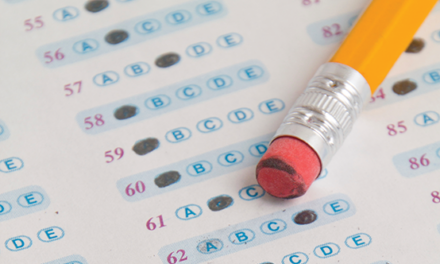
Children who face mental health challenges sometimes present teachers with moral or ethical dilemmas of following the rules or helping the child.
Truth: Sometimes teachers don’t have all the answers. Actually, many times. Sometimes moral and ethical dilemmas that we are not prepared for bubble up because they don’t fit the black and white lettering of our school policies. We face complex situations with students, and we struggle to figure out what’s best for the children placed in our care.
I have spent seven of my 10 years teaching in high-needs schools, serving students who have not only academic needs but an array of social-emotional needs. I do everything within my power to help students succeed in school and in life beyond school. But there have been a few times when that means I have confronted some really murky legal, ethical, and moral issues. I have tended to make decisions that are morally sound that will let me sleep at night even if those decisions come with some risk for me.
I have tended to make decisions that are morally sound that will let me sleep at night even if those decisions come with some risk for me.
I’m not alone. Supporting students with mental health issues is becoming more common even as resources to help teachers and students confront these issues are quickly dwindling. Decreased education spending has led to reductions in the number of guidance counselors, social workers, and other personnel who could stand beside teachers and students during difficult times. Teachers are on the front lines trying our best, but most of us don’t have the training and support to tackle these serious student needs alone.
This leaves me with so many questions. What are our obligations — legal, moral, ethical — as teachers? How do we balance attending to the severe needs of one child against our duty to all the other students in our classrooms who need our help and support as well? Where do we go for help, for resources? And how do we help ourselves and colleagues with the emotional labor that comes with supporting our neediest students?
Breaking the rules
A few years ago, Keyana was one of my 4th-grade students. She had been raised by her father in the Caribbean but had recently reunited with her birth mother in the U.S. She suffered from severe depression, attachment issues, and anxiety. She was quite withdrawn at school and spent much of the time with her head on her desk, only connecting with other students through infrequent and sporadic verbal lashings. Her mind, heart, and soul were clearly in another place.
One morning, one of Keyana’s friends came rushing in. “Ms. A! Ms. A! Keyana needs you . . . it’s an emergency!” I bolted into the girls’ restroom to find Keyana crumpled on the tile floor, deliriously speaking through veils of tears. She said she wanted to take her own life. Hearing those words from a 10-year-old has to be the most difficult thing I have ever faced as a teacher. My heart sank, I pushed back tears as questions swirled through my head. I squelched all the fear and sadness as I searched for the right words, the right move to help one of my favorite students.
The school year proceeded in a series of ups and downs for Keyana, including two ambulance trips due to suicide threats, several hospitalizations for mental health services, three attempts at running away, and one stint in a group home for troubled girls. I broke the rules and gave Keyana my personal phone number, telling her to call me if she was ever in trouble from her own thoughts or the actions of others. I told her I would be there.
All of these actions may have gone against school district policies but not against the policies of my heart and head.
I think about the times that Keyana called my home phone and wonder what would have happened if she hadn’t reached out for help at those moments. And what about Kelly who texted me from the middle-of-nowhere Florida in the middle of the night, after running away from her father? I wonder what would have happened if I hadn’t answered the plea from Faye’s mother and helped her move herself and her three daughters out of their house while her abusive husband was at work. I don’t regret giving them a safe place to sleep for a night. And I don’t regret picking up Tyrique every morning on my way to school so he could arrive on time for the small group instruction he needed. All of these actions may have gone against school district policies but not against the policies of my heart and head. They also made me keenly aware that we need more conversations about how these seemingly black-and-white policies are really shaded in a multitude of grays and might be better addressed on a case-by-case basis.
What I’ve learned
I still grapple with many of my choices and wonder how I might have gone about things differently. I do NOT recommend a complete and blissful ignorance of the rules and policies put into place to legally protect teachers and students. I’ve certainly learned a great deal from considering my actions over the years. Here are a few tips that I offer to other teachers who are supporting students with mental health issues:
#1. Seek help from your peers. Collaborate and problem solve together.
We must step out of our silos and work together. Ask questions of experienced teachers, reach out to guidance counselors and any other support professionals in your school or district. Ensure that you respect the anonymity of the student while doing so, but find help.
#2. Work closely with the student’s family.
One big mistake I made was not contacting a student’s family soon enough. In most situations, parents and other family members are our allies, our partners. As a newbie to parenting myself, I also have learned that no matter how big or how small the issue, I crave being informed about anything that goes on in the classroom. Communication matters.
#3. Learn about available resources.
Many districts have partnerships and programs to support students; teachers just have to ask. I’ve found counseling and support services for families, mentoring programs, even free sessions with outside therapists. I just had to ask and do a little digging. First step: See the guidance counselor or school psychologist.
#4. Never make assumptions. Never assume something is a small issue; to a child, it’s all big.
Sometimes I have been so busy with other students in the classroom that I have missed a child’s initial plea for help by making the assumption that it wasn’t serious. My lesson learned: It’s not really my job to decide if it’s serious, but it is my job to find people who have the skills to help make that decision. I have to do a better job listening.
#5. If you have any inkling that a child is in crisis, let someone know.
As mandated reporters, educators must report any suspicions of neglect or abuse. The same thing should stand for children in crisis. If you have any idea that a child is having a mental health issue or is in crisis, go to your school guidance counselor or administration. Pronto.
#6. Don’t be afraid to reach out to students and ask how they are doing.
Sometimes all students need is having someone ask them “How are you today?” Those little words can do wonders. In college, my mother was diagnosed with pancreatic cancer and given two months to live. I was at a dark place, and, thankfully, a professor reached out to me. It made all the difference in the world.
Final thoughts
No situation with a child in crisis is easy. But teachers can be a vital link between students with mental health issues and the help they need. Because teachers spend so many hours every day with these children, we are uniquely able to detect subtle changes in their behavior that may signal an underlying problem. Teachers can’t be expected to handle every crisis, but they can alert those who are able to expertly deal with children in need.
In addition, teachers can also be powerful advocates for ensuring that states and districts adequately fund support positions and professional development. As the last PDK/Gallup Poll on the Public’s Attitudes Toward the Public Schools showed, the American public has high trust and confidence in teachers. Let’s use that to our advantage and speak out in support of policy and funding changes that will return counselors, psychologists, and other support personnel to our schools.
Citation: Allen, M.M. (2014). Crossing a broad gray line to help children. Phi Delta Kappan, 96 (4), 19-21.
ABOUT THE AUTHOR

Megan M. Allen
MEGAN M. ALLEN is a National Board Certified Teacher, a program developer, and visiting instructor in the Professional and Graduate Education Department at Mount Holyoke College, South Hadley, Mass. Allen was the 2010 Florida Department of Education/Macy’s Teacher of the Year in the middle childhood generalist category.










